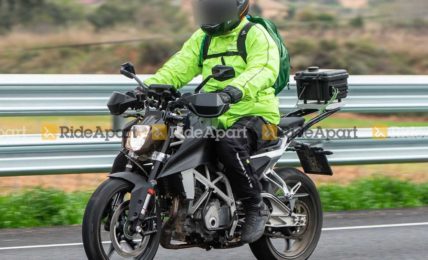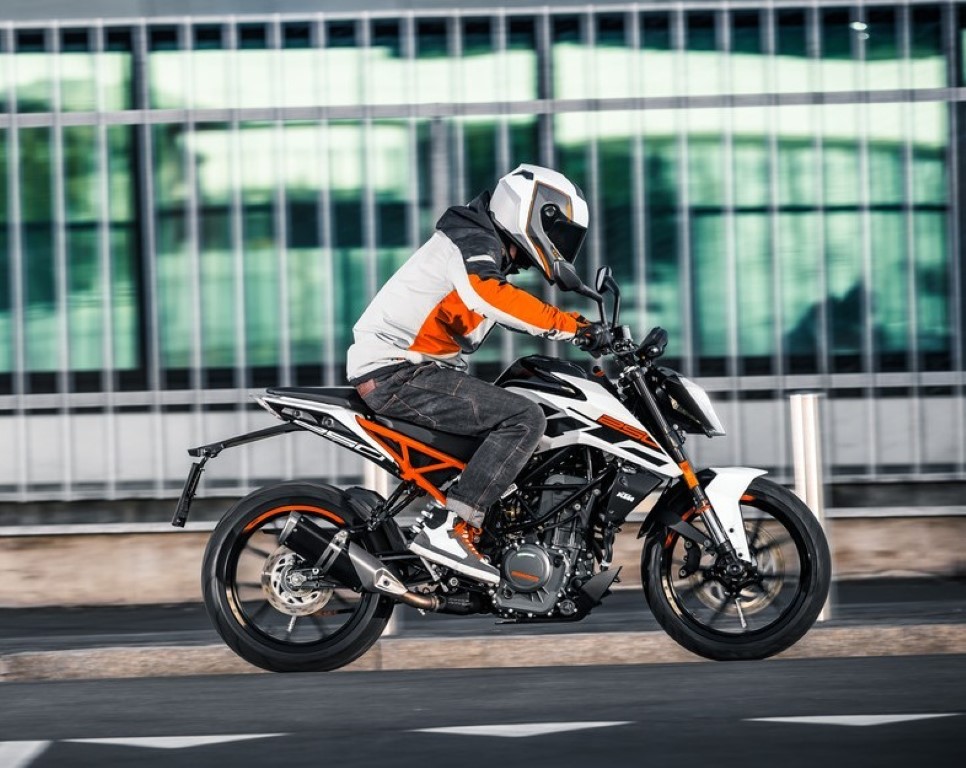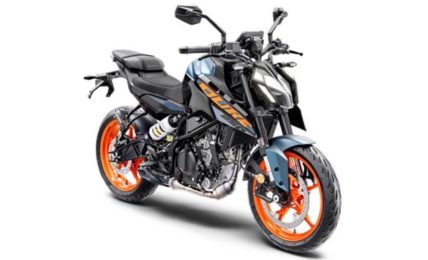The seating position is better suited to attacking corners than munching miles
Ergonomics – The erstwhile Duke series has won accolades for its committed riding position, more so when we bring its faired RC sibling into the picture. KTM has tweaked the riding position ever so slightly with this generation of the Duke, as the saddle height has seen an increment and the footpegs are more rear-set, resulting in a slight forward-bent position for the rider. The wide handlebar, as always, remains within easy reach of the rider and the keyhole now sits closer to the tank. The dedicated position does take away the comfort factor of an upright posture but enhances confidence on corners by leaps and bounds. Mind you, the new position isn’t as tiring as it looks and the Duke 250 still remains a good companion for those longer stints. Courtesy these new split seats which offer more seatbase area and a substantial amount of cushioning. They are well-finished too and offer good support to both the occupants which wasn’t the case earlier. Of special mention are the grab rails which offer the best of form and function.
The BS4 compliant engine tips the scales at 37.2 kgs
Performance – In the past, KTM has proved its mettle with numerous products that offer oodles of performance. The 248.8cc single-cylinder mill of the 2017 Duke 250 is no different! This liquid-cooled motor is a downsized derivative of KTM’s 373cc powerplant and generates 29.5 BHP of power and 24 Nm of torque. As compared to export-spec Duke, power is down by 1 BHP but that’s about it. This powerplant is as eager as other KTM engines we have tested in the past. While the responsiveness and grunt in the latter half of the rev band is satisfactory by quarter-litre standards, the low-end performance is nowhere close to even the Duke 200. The Duke 250 lacks the urgency of the Duke 200 but thanks to the healthy spread of torque, it comes into its own past 5000 RPM. From that point onwards, the throaty tune from the exhaust only adds to the experience!
The Duke 250 is agile and changes direction at the drop of a hat!
There is no looking back once you cross the 5000 RPM mark on the Duke 250
The Duke 200 had already set the benchmark very high in terms of performance. Going by that cracker of a machine, we had expected a bit more from the 2017 Duke 250. With a 0-100 km/hr sprint record of 8.7 seconds, this is no out-and-out performer and there is no huge improvement in the top speed as well. On the other hand, what has improved is engine refinement and that signature KTM harshness is nowhere to be seen! Nevertheless, this is not to be confused with engine vibrations which do creep in as you approach the redline. The 6-speed gearbox comes with slipper clutch to assist downshifts and is a joy to use. This tranny is definitely the best in business and does its task very well. Fuel efficiency hovers around the 30 km/l mark. Asserting the tourer-friendly nature is the fuel tank which now gulps in 13.5-litres of petrol to give a substantial range.
This quarter-litre machine takes on corners like nobody’s business
Riding Dynamics – Standing firm on its improved split Trellis frame, the 2017 KTM Duke 250 comes with terrific handling and dynamics. To tackle diverse Indian roads, the motorcycle is equipped with WP Suspension hardware which comprises of open-cartridge upside down forks at the front and a monoshock unit at the rear with adjustable preload. While there is an underlying stiffness to the ride, the Duke feels totally at home going over bad roads or doing some extreme lean angles. The motorcycle throws minimal tantrums in corners and, coupled with its tamer power delivery, is more forgiving too. The changed riding position also plays its part in improving flickability of the motorcycle.
Open-cartridge WP USD forks make a huge difference in handling and stability
The Duke 250 is much more forgiving than its elder sibling due to lesser performance
Despite its higher price, heavier weight and stronger powertrain, the entire braking hardware on the Duke 250 is carried over from the 200cc counterpart. This also means that ABS has been coolly given a miss. Disc brakes, measuring 300 mm at the front and 230 mm at the rear, are not upto the task. Make no mistake, the Duke 250 stops in time without any drama. But definitely not with the same amount of feel and confidence you expect when shelling out two big ones. Bite from the front end is lacking and so is the rider’s confidence because under the helmet, you know that there is no electronic aid watching your back! In another cost-saving attempt, rubber has been downgraded from the super-sticky Metz to the mediocre MRF Revz.




